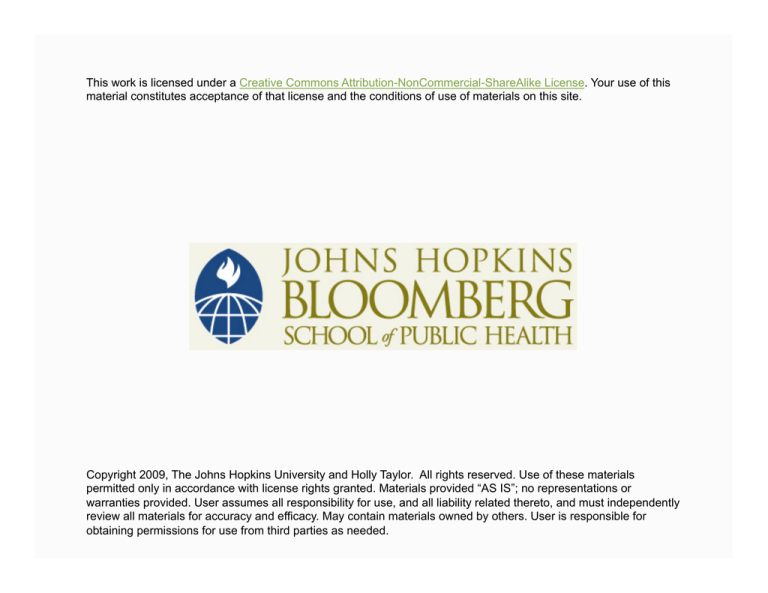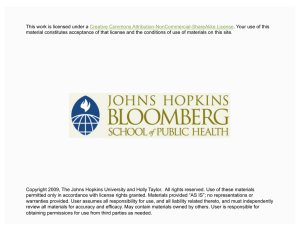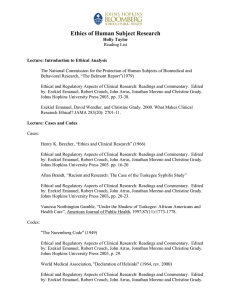
This work is licensed under a Creative Commons Attribution-NonCommercial-ShareAlike License. Your use of this
material constitutes acceptance of that license and the conditions of use of materials on this site.
Copyright 2009, The Johns Hopkins University and Holly Taylor. All rights reserved. Use of these materials
permitted only in accordance with license rights granted. Materials provided “AS IS”; no representations or
warranties provided. User assumes all responsibility for use, and all liability related thereto, and must independently
review all materials for accuracy and efficacy. May contain materials owned by others. User is responsible for
obtaining permissions for use from third parties as needed.
Ethics Framework
Holly Taylor, PhD, MPH
The Johns Hopkins Berman Institute of Bioethics
Section A
Background and Introduction of Framework, Part 1
Background
Development of framework
Purpose of framework
4
Background: Principles
Introduction to ethical principles (Belmont)
- Beneficence
- Justice
- Respect for persons
- AMENDMENT: Integrity/responsibility
5
Background: Review of Guidance
Review of contemporary guidance documents
- Council for International Organizations of Medical Sciences
(CIOMS), (2002)
International Ethical Guidelines for Research Involving
Human Subjects
- Indian Council on Medical Research (2006)
Ethical Guidelines for Biomedical Research on Human
Participants
6
Background Review
Review of contemporary guidance documents
- Emanuel, Wendler, and Grady. (2000, May 24–31). What makes
clinical research ethical? JAMA, 283, 20, 2701–2711.
- Emanuel, Wendler, Killen, and Grady. (2004, March 1). What
makes clinical research in developing countries ethical? The
benchmarks of ethical research. J Infect Dis, 189, 5, 930–937.
7
Background: Purpose
Purpose of framework
- Promote systematic approach to case analysis
8
Framework
9
Framework: Basics
Process of analysis may lead user to revisit prior directions/
questions
Not all directions/questions will be relevant in the analysis of every
case
Final product of analysis
- Recommendation for action
- Justification for recommendation drawn from what is learned in
process of analysis
10
Framework: Facts
Review the facts of the case
11
Framework: Concerns/Challenges
Identify the potential moral concerns or challenges raised by the
case
12
Framework: Principles/Requirements
Which ethical principles/requirements are associated with each
concern, challenge raised?
- Principles/requirements meant to remind user of range of issues
that might be relevant
- Few cases will raise all principles/requirements listed
13
Framework: Principles/Requirements
Beneficence
- Scientific validity
- Social value/essentiality
- Precaution and risk minimization
- Favorable risk-benefit ratio
- Dissemination of results
- Local capacity building
14
Framework: Principles/Requirements
Justice
- Fair selection of study population
Protection of rights and welfare of vulnerable subjects
- Non-exploitation
Fair benefits
- Relevance to the community from which study sample to be
drawn
15
Framework: Principles/Requirements
Respect for persons/study communities
- Informed consent
Voluntariness
- Community/engagement agreement
- Privacy and confidentiality
- Compensation for research-related injury
- Post-trial access to beneficial interventions
16
Framework: Principles/Requirements
Integrity/responsibility
- Professional competence
Data management
- Collaborative and non-exploitative partnership among
investigators
- Negotiated and equitable ownership of research findings
- Accountability and transparency
Independent ongoing review
- Regulatory compliance
17




